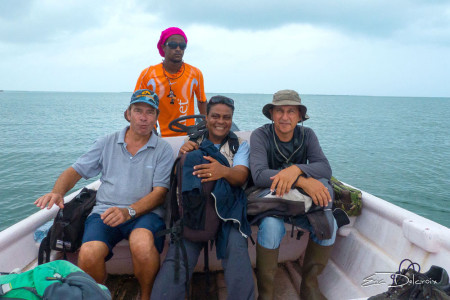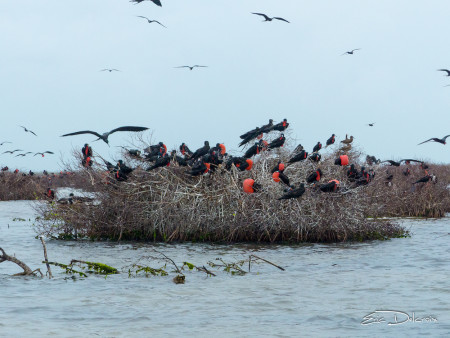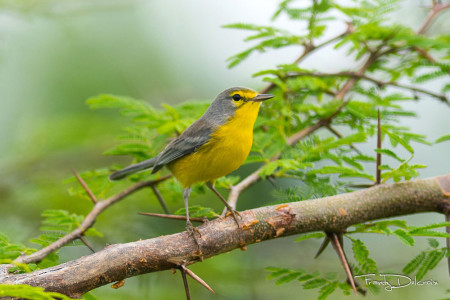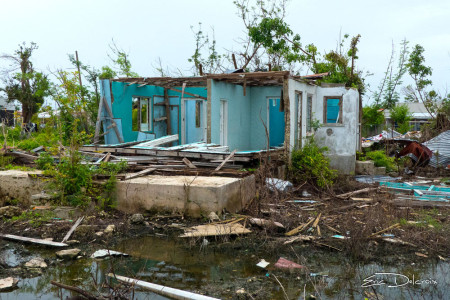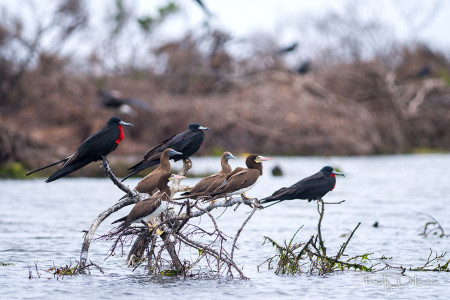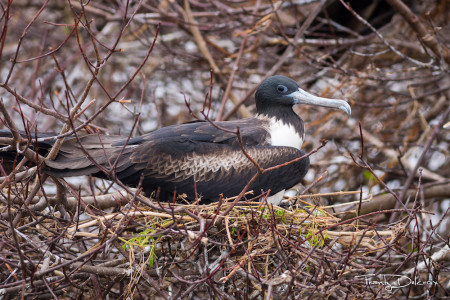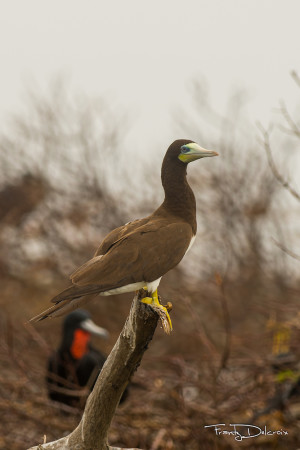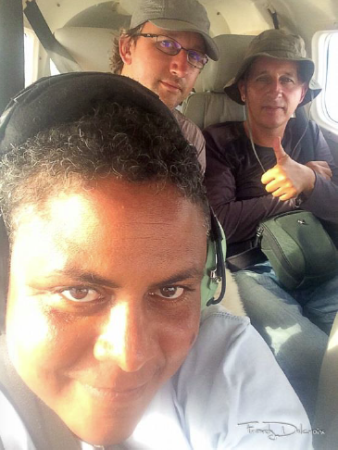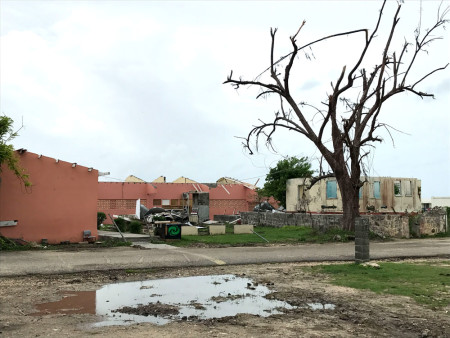
On September 6th, 2017, a Category 5 hurricane named Irma made landfall on the tiny island of Barbuda, devastating homes, stripping the forest bare, and inundating parts of the island with seawater. We all looked on in shock as the way of life for many Barbudans was destroyed. We also feared another disaster was in the making.
Barbuda is the only home for the small Barbuda Warbler, a close relative of the Saint Lucia and Adelaide’s Warblers. Scientists and conservationists alike feared that Irma may have caused its extinction. Even if the birds survived the ravages of the wind and rain, the food they needed to survive (caterpillars and other insects) would be greatly reduced immediately following the storm. Hurricanes have triggered extinctions in the past, on much larger islands like Cozumel. There the endemic Cozumel Thrasher is now presumed extinct, following a series of hurricanes beginning with Gilbert.
Unsafe conditions and travel restrictions to Barbuda prevented an immediate population assessment but as soon as was possible, several members of the Environmental Awareness Group (EAG) of Antigua, under the guidance and support of the Department of Environment (DoE), visited Barbuda. The group confirmed that some warblers had survived. BirdsCaribbean, EAG, Fauna & Flora International (FFI) and the DOE quickly teamed up to organize and carry out extensive surveys on Barbuda, to assess both the Barbuda Warbler and Yellow Warbler populations.
An Exciting Journey
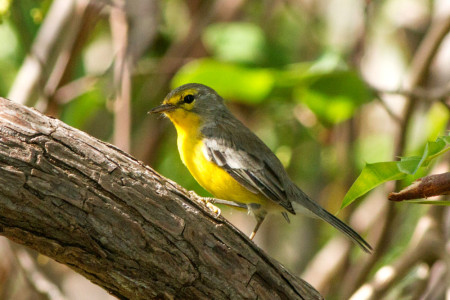
On October 15, less than six weeks after the hurricane, a team of 6 left St John’s, Antigua by boat to cross the 40 miles to Codrington, Barbuda. High seas and heavy rain made it an interesting passage, but we arrived at the Codrington port to be greeted by the team from Guadeloupe: Anthony Levesque, Frantz Delcroix, and Eric Delcroix of Association AMAZONA, a conservation organization in Guadeloupe. They had just arrived by plane (read their story here) to conduct counts at the Magnificent Frigatebird Sanctuary. Though the stormy morning quickly turned to a bright, sunny day, our moods turned somber as we saw first-hand the extensive damage done by Irma. Many homes and businesses were completely destroyed, and rebuilding efforts by the handful of Barbudans on the island were only just beginning.
Our home for the next week was the DoE office in Barbuda, where we settled in, organized the surveys and made some last-minute refinements to the distance sampling protocol for data collection. We conducted observer training for the team members and field tested the protocol, which included a playback of Yellow and Adelaide’s Warbler calls. The Barbuda Warbler is very closely related, and was once considered the same species as the Adelaide’s Warbler of the Greater Antilles and the Saint Lucia Warbler. Recent genetic studies have confirmed that these three should be treated as distinct species, though their vocalizations are very similar. The field test, made on the edge of town, was a success and we recorded our first Barbuda and Yellow Warblers, along with a number of migratory shorebirds (view the eBird list).
An International Team Gets to Work
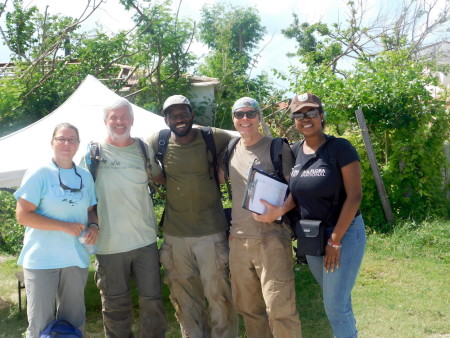
Shortly after sunrise the following day, the two teams of three observers began the survey with a mixture of excitement, hope and dread. Frank Rivera-Milan (US Fish and Wildlife Service) was joined by Kelvin ‘Biggz’ Samuel and Dwayne Philip (Antigua Forestry Unit). Jeff Gerbracht (Cornell Lab of Ornithology) joined Lenn Isidore, (Saint Lucia Projects Coordinator for FFI) and Rudolph Zachariah (Antigua Department of Environment). Nearly as important as the current population assessment was providing that the training and resources to DOE and EAG staff, to ensure that the Barbuda Warbler population can be monitored long term. To this end, we were also joined by Sophia Steele (Fauna & Flora International) and Shanna Challenger (EAG, DOE and FFI), to learn about the methodology and gain the necessary field experience. That first morning both teams observed Barbuda Warblers and Yellow Warblers while surveying 19 points (view eBird list from that first morning). It was a great start but still a long way to go.
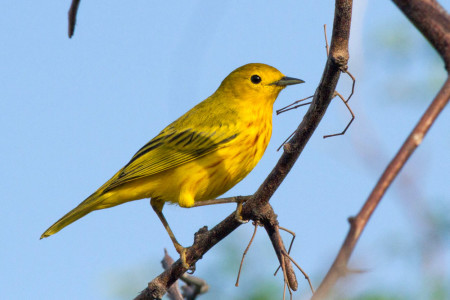
Barbuda has about 62 square miles of land and prior to our arrival, Population Ecologist and team member Frank had randomly selected the survey points, which were loaded into our GPS units. Points were at least 400 meters apart. Each team was tasked with covering as many points as possible before late morning arrived, when the warblers became quiet and harder to observe. A typical survey consisted of walking from point to point, covering up to eight miles in a morning. At each point, the team would divide up the tasks. One person would categorize the habitat, food availability and disturbance at each site, while the others would look and listen for Barbuda Warblers. Each observation of a warbler was recorded, along with the distance and direction from the point to each individual bird. “Barbuda Warbler singing between 20 – 30 meters at 110 degrees from North” or “Yellow Warbler seen at 18 meters distance, 35 degrees”. All observations were recorded in detail so that detection probability, occupancy and abundance (density and population size) could be modeled and estimated as precisely and accurately as possible.
Nature is Resilient, But There’s Some Way to Go
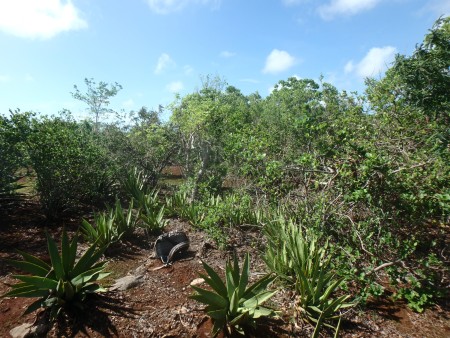
During that first morning of surveys, we were all struck by the resiliency of the natural world and how the forests of Barbuda were so well adapted to hurricanes. Weeks earlier the forests had been stripped bare of all greenery; yet the forest was already recovering. Amidst the broken branches and downed trees, life was returning with a vengeance. Trees and shrubs had already put out new leaves and in some cases, flowers and even fruit were in evidence. In addition to the ever-present mosquitoes, we saw lots of other insects and caterpillars, i.e. warbler food. The forest seemed green and alive, in sharp contrast to how it must have appeared just a few weeks earlier.
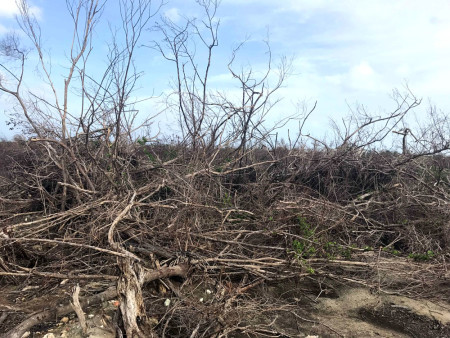
Unfortunately, other parts of the island weren’t faring nearly as well as the interior. Lowlands on the south of the island were especially hard hit by the storm surge. The forest there was struggling to recover.
To cover as many points as possible, the two teams stayed in different parts of the island. Henry, our driver and guide for the week, made sure that the teams got to where we needed to be. Our daily routine was pretty much the same: Leave for the field early; cover as many points as possible by 10:30; hike back out of the bush to be met by Henry; a quick lunch in town followed by an hour of down time; then back in the field between 2:30 and 5:30. In the evenings, we would review the data collected during the day to make sure everything was in order.
Hopes for Beautiful Barbuda’s Sustainable Recovery
An emotional roller coaster is a good way to describe how I felt throughout the week. Each day we were reminded of the devastation left by the hurricane and the long road to recovery for the Barbudan families. And each day we observed firsthand how the forest is recovering and how well the Barbuda Warbler fared. Barbuda is an island with very little development and miles of natural scrub and forest. The land is communally owned so there are few signs of outside development and that community ownership is reflected in the pride Barbudans feel for their island. I can think of few places where there are still miles of beach or forest with no development or human habitation in sight. This is pristine habitat for the birds. It is also the perfect location for eco-tourism: not only birding, but caving, horseback riding, snorkeling and other pursuits. It’s a rare gem, and the expanse of untouched natural habitat has surely been key in the forest’s rapid recovery.
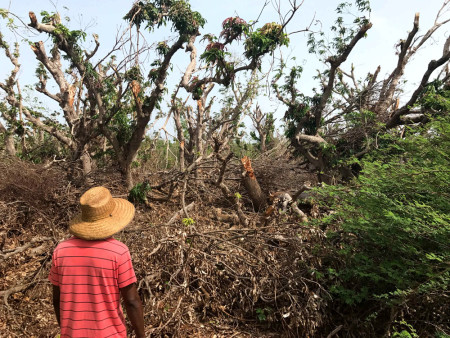
We had been given permission for one week to conduct these surveys. It came to a close all too soon. With 125 points surveyed once, and 37 points surveyed twice, 50 miles walked and 145 Barbuda Warblers detected, we felt that we had covered as much of the island as possible (eBird list from the final day). Once the numbers are crunched and population models run, we will have a much better estimate of the Barbuda Warbler population (stay tuned!). However, the good news is that all evidence points to a population, which somehow survived Irma’s fiercest onslaught.
As we left the island, we also left part of ourselves there – literally, in the case of the mosquitos and sand flies! In our hearts, there was the sorrow – and also hope – we feel for the Barbudans, their way of life and the island’s natural ecosystems. As more and more of the Caribbean becomes dominated by resort developments, Barbuda is a wonderful and refreshing contrast; a place where the natural world is still evident in abundance. We wish Barbuda a steady, sustainable recovery that will benefit its people and where its beautiful natural habitat will continue to flourish.
By Jeff Gerbracht, lead architect and software engineer at the Cornell Lab of Ornithology and co-chair of the BirdsCaribbean Monitoring Working Group. Jeff has assisted Birdscaribbean for many years with eBird Caribbean, and monitoring and training workshops throughout the region.
Frank, Lenn and Jeff would especially like to thank the many individuals who made this population assessment possible, several of whom were also trying to rebuild their own lives on Barbuda:
- Kelly Burton and Henry Griffin for ensuring our stay on Barbuda was as comfortable and productive as possible; Wanda for the excellent lunches; and Len Mussington for the exciting boat ride from Antigua to Barbuda.
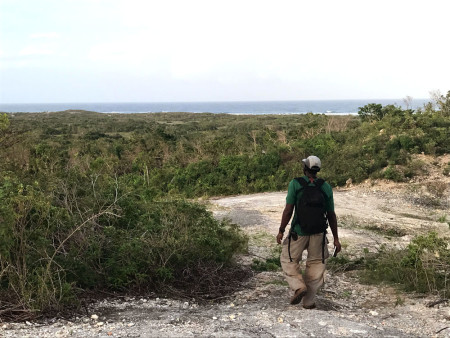
We also thank EAG, DOE, Cornell Lab of Ornithology, Fauna and Flora International and BirdsCaribbean for their practical support, including the following individuals:
- Shanna Challenger and Sophia Steele of Fauna & Flora International/EAG;
- Rudolph Zachariah of the Department of Environment, Antigua;
- Kelvin Samuel and Dwayne Philip of the Antigua Forestry Unit;
- Sasha-gay Middleton of the Department of Environment for organizing our meals;
- Matt Young of the Macaulay Library, Cornell Lab of Ornithology for putting together the warbler playback; and
- Special thanks to Natalya Lawrence of EAG and Dr. Helena Jeffery Brown and Ruleta Camacho Thomas of the Department of Environment, for organizing so many of the necessary logistics.
BirdsCaribbean is grateful to all that have donated so generously to our ongoing fundraising effort for hurricane relief for our partners and beloved birds that has allowed us to send nectar feeders and bird seed to 13 islands and help our partners with surveys, replacing equipment lost in the storm, and other recovery actions.
Hover over each photo to see the caption; click on photos to see larger images and a slide show.














Bird Species Observed on Barbuda (54)
- White-cheeked Pintail – Anas bahamensis
- Helmeted Guineafowl – Numida meleagris
- Magnificent Frigatebird – Fregata magnificens
- Brown Booby – Sula leucogaster
- Brown Pelican – Pelecanus occidentalis
- Cattle Egret – Bubulcus ibis
- Green Heron – Butorides virescens
- Osprey – Pandion haliaetus
- American Oystercatcher – Haematopus palliatus
- Black-bellied Plover – Pluvialis squatarola
- American Golden-Plover – Pluvialis dominica
- Semipalmated Plover – Charadrius semipalmatus
- Whimbrel – Numenius phaeopus
- Ruddy Turnstone – Arenaria interpres
- Stilt Sandpiper – Calidris himantopus
- Sanderling – Calidris alba
- Least Sandpiper – Calidris minutilla
- White-rumped Sandpiper – Calidris fuscicollis
- Pectoral Sandpiper – Calidris melanotos
- Semipalmated Sandpiper – Calidris pusilla
- Long-billed Dowitcher – Limnodromus scolopaceus
- Spotted Sandpiper – Actitis macularius
- Greater Yellowlegs – Tringa melanoleuca
- Willet – Tringa semipalmata
- Lesser Yellowlegs – Tringa flavipes
- Lesser Black-backed Gull – Larus fuscus
- Royal Tern – Thalasseus maximus
- Least Tern – Sternula antillarum
- Scaly-naped Pigeon – Patagioenas squamosa
- White-crowned Pigeon – Patagioenas leucocephala
- Eurasian Collared-Dove – Streptopelia decaocto
- Common Ground-Dove – Columbina passerina
- White-winged Dove – Zenaida asiatica
- Zenaida Dove – Zenaida aurita
- Mangrove Cuckoo – Coccyzus minor
- Antillean Crested Hummingbird – Orthorhyncus cristatus
- Belted Kingfisher – Megaceryle alcyon
- American Kestrel – Falco sparverius
- Caribbean Elaenia – Elaenia martinica
- Lesser Antillean Flycatcher – Myiarchus oberi
- Gray Kingbird – Tyrannus dominicensis
- Black-whiskered Vireo – Vireo altiloquus
- Barn Swallow – Hirundo rustica
- Scaly-breasted Thrasher – Allenia fusca
- Pearly-eyed Thrasher – Margarops fuscatus
- American Redstart – Setophaga ruticilla
- Tennessee Warbler – Oreothlypis peregrina
- Yellow Warbler – Setophaga petechia
- Blackpoll Warbler – Setophaga striata
- Barbuda Warbler – Setophaga subita
- Bananaquit – Coereba flaveola
- Black-faced Grassquit – Tiaris bicolor
- Lesser Antillean Bullfinch – Loxigilla noctis
- Bobolink – Dolichonyx oryzivorus
- Carib Grackle – Quiscalus lugubris
Read more about the Fall 2017 hurricane impacts on Caribbean birds:
#BarbudaStrong—Guadeloupe Bird Survey Team Plays Good Neighbors following Hurricane Irma
Bird Dispatches from the Hurricane Front Lines
Good news! Conservationists Excited to Find Surviving Barbuda Warblers on Devastated Island






























